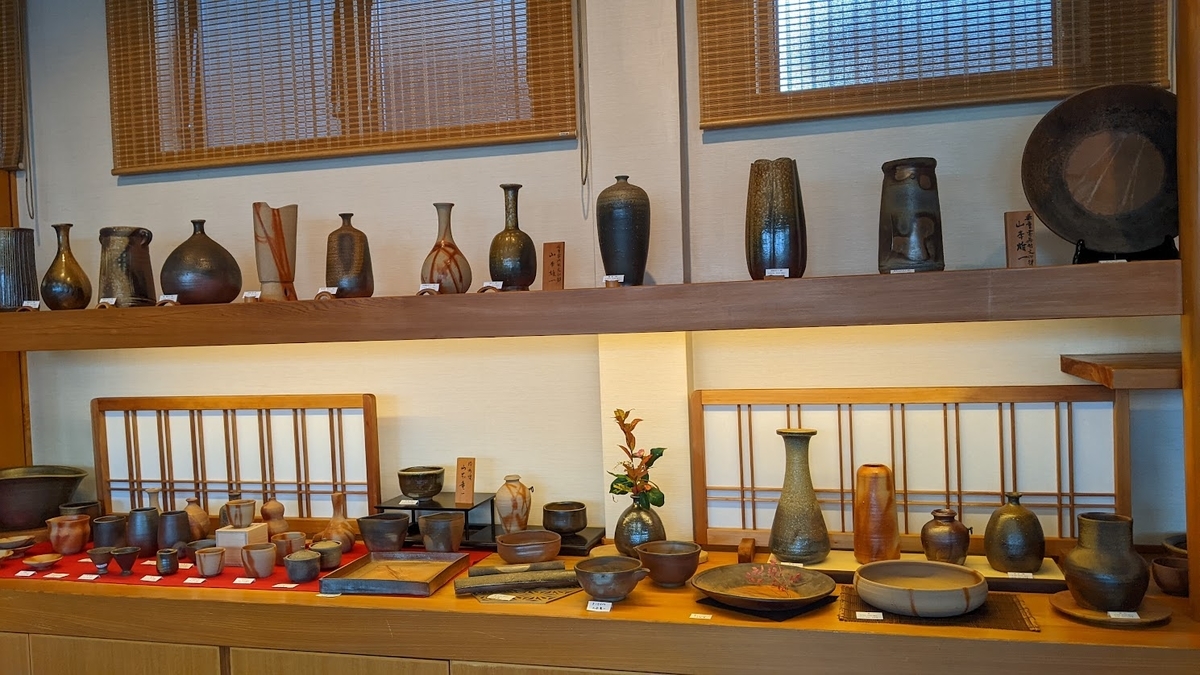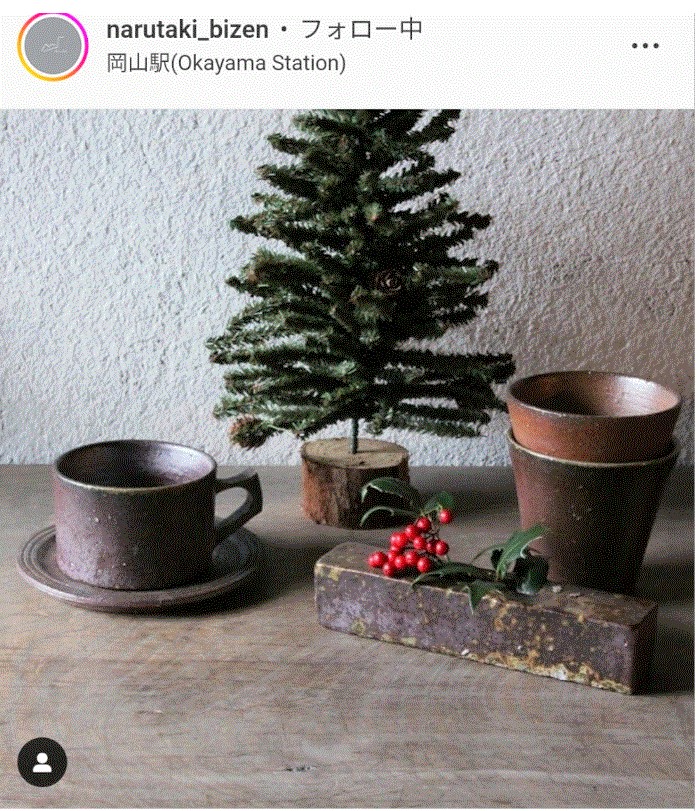備前焼の伊部へ/ Return to Bizen Ware in Imbe





今日は岡山県備前市を訪ねました。私が生まれて2,3歳くらいまで備前に住んでいましたが、当時の記憶はなく、よく両親に聴いていたものです。父がこちらで事業を行っていたため、備前市がある東備地区や、備前市周辺を産地とする備前焼や窯元とは、御縁があり、自宅でも備前焼に囲まれて育ちました。備前焼は、備前市伊部地区で盛んであることから「伊部焼」との別名もあり、日本六古窯の一つに数えられます。考えてみると、学生時代から美術や芸術が好きで、日本や英国の大学で、英米・アイルランド文学, 美術史・Art Curator (学芸員)の学位で学んだのですが、素地はこのような環境も多少は影響していたのかと思います。
この度は、父と親交の深い備前焼作家の山本雄一・竜一さん宅を訪れました。(御宅にはGalleryも隣接しており、近隣に祖であられる人間国宝の故山本陶秀氏案の門下の弟子養成所兼、陶芸体験のできる窯元や別途Galleryがありますが、Galleryのリンクも記しておきます。)竜一さんとは、最近、帰省時に訪れたり、個展に伺ったり、私の備前焼への興味から、ご厚意で色々とご指導頂いているのです。
備前焼の歴史
備前焼は、1000年以上の歴史を誇り、その古くは、神社に奉納していた慣習から始まるとお聞きました。私が調べたところでは、起源は、備前市南部から瀬戸内市、岡山市内には古墳時代から平安時代にかけての須恵器窯跡が点在しており、この須恵器が今の備前焼に発展したと考えられています。8世紀になると備前市に窯が築かれ始め、12世紀には伊部地区に窯が本格的に築かれて、独自の発展へと進んだようです。鎌倉時代初期は、酸化焔焼成による現在の茶褐色の陶器が焼かれ、水瓶や擂鉢など実用的なものが落としても壊れず評判が良く、この当時の焼き物を古備前と呼び重んじられています。室町から桃山時代には、茶道の発展と共に茶陶としての人気が高まっていきました。江戸時代には、茶道の衰退と安価な大量生産の磁器が現れて来たため一時期には衰退しましたが、昭和に入り、多くの陶芸家が、主に実用品などで、原点回帰を図り、芸術性を高めて復興させることで、複数の重要無形文化財「備前焼」の保持者、人間国宝を輩出し、国家や地域からも長い歴史から伝統工芸として、守護されながら、世界の美術館等にも展示される程、備前焼の人気は安定したものとなっていったようです。
備前焼 現代の食と暮らしとの調和
今回は、新鋭の備前焼作家さんの中でも、個性的な取り組みにチャレンジしておられる安藤騎虎さんの工房と窯「鳴滝窯」を御紹介頂きました。最近、店舗を改築されたばかりということで、自然木を基調とした、おしゃれなインテリアと、現代の生活に馴染む、軽快な趣の素敵な作品群と展示を見ることができました。
安藤さんは、東京都心のミッドタウンなどの施設で、異業種の方々のコラボレーションにも意欲的に参加されており、備前焼に、食材を使った表現や料理との調和で、その味わいを伝える等、食事と共に備前焼の美点や特徴を体感出来るインベントを開催されたりしていらっしゃいます。
特に、私が気に入ったのは、モダンでおしゃれなコーヒードリッパー・サーバーで、一人用や、複数人用があります。素焼きの備前焼の優しい肌触りに、コーヒーの美味しさが倍増しそうに思いました。私が陶器は壊れやすいのではと心配していたら、備前焼はかなり丈夫なので、日常使いにも安心して活用出来ますよと教えて頂きました。
この度は、写真撮影を失念してしまいしたので、安藤さんのInstagramで、作品の魅力をご覧頂けたら良いと思い、下記に記しておきます。
*画像はInstagramより借用しています。



■安藤騎虎さんInstagram
備前焼 鳴瀧窯 narutaki (@narutaki_bizen)
https://www.instagram.com/narutaki_bizen/?hl=ja
このように備前市伊部には、現代の暮らしにも見合った、毎日の生活に馴染む深い味わいの器や、品々が揃う窯元やGalleryが点在しています。また、市内には日本遺産に認定された旧閑谷学校があり、南西に隣接する瀬戸内市には刀剣の産地である備前長船もあり、地域独特の伝統が残る場所なので、是非足を運んでみてください。今後、備前焼の特徴や、種類、窯の焼き方など、備前焼の魅力をお伝えできる機会が出来たらと思っています。
行き方:JR赤穂線 伊部駅下車周辺(岡山市より電車・車で1時間弱)

*旅する 千年 六古窯 より借用
-------------------------------------------------------------------------------------
Return to Bizen Ware in Imbe
I visited Bizen City, Okayama Prefecture on November 3, 2022, on Culture Day. I lived in Bizen until I was 2 or 3 years old. My father had a business here so I had have been familiar with with Bizen ware, which is produced in the Tobi district where Bizen City is located and the area around Bizen City. Therefore, I grew up surrounded by Bizen ware at home. Bizen ware is also known as "Inbe ware" because it is popular in the Imbe district of Bizen city, and it is counted as one of the Six Ancient Kilns of Japan. If I recal, because of these environment since a child, I have been interested in fine arts since I was a young student. After obtaining a qualification of the art curator at the university in Japan, I visited to majoring in as History & Theory of Art and the art curator training at a graduate school in UK.
Bizen Ware and Modern Life
This time, I visited the home of Mr. Yuichi Yamamoto and Mr. Ryuichi Yamamoto, Bizen pottery artists who are close friends with my father. (There is also a gallery next to the house and there is a disciple training school and a pottery workshop where you can experience pottery and a separate gallery nearby, which was proposed by the late Toshu Yamamoto, who was a national treasure.) I have visited to Mr. Ryuichi Yamamoto when I was returning home and I have visited their solo exhibition in Tokyo.
This time, I was introduced to the workshop and "Narutaki Kiln" of Mr. Kiko Ando, one of the up-and-coming Bizen ware artists who is challenging himself with his unique approach. The gallery has just been renovated recently, so I was able to see the stylish interior based on natural wood and the wonderful works and exhibits with a bright taste that blends in with modern life. Mr. Ando enthusiastically participates in collaborations with people from different industries in popular places such as the Midtown in central Tokyo. They also hold events where we can experience the beauty and characteristics of Bizen ware. I especially like the modern and sleek coffee dripper server, available for single or multiple users. I thought that the gentle texture of unglazed Bizen ware would be more tasty of coffee. At first, I was worried that pottery would break easily, but he told me that Bizen ware is quite durable and can be used on a daily basis without worry.
I enjoyed so much in talking therefore I forgot to take a picture.
I hope you can see the fascination of the work on Mr. Ando's Instagram, so I will write his account address below.
■Kiko Ando's Instagram
https://www.instagram.com/narutaki_bizen/?hl=ja
■ History of Bizen Ware
(I am attaching here about the history of Bizen Ware by JOHN THOMAS WELLS from the Okayama Bizenyaki Touyukai.)
”The oldest ceramic shards to be found in the world were discovered in Japan and date back some 12,400 years. That was the pottery of the Jomon (12400-250BC) culture, followed by the Yayoi (250BC-250AD) culture, which was open pit-fired, porous, and made without a potter’ s wheel. In the fifth century potters and other technical experts were invited to Japan from what is now Korea Inception of technically advanced Sue ware took place at that time bringing to Japan the potter’s wheel and anagama tunnel kiln. Sue ware was made throughout Japan and is the origin of Bizen ware. Sue pottery is characterized by having a sharp, fine, delicate, form, thin walls, and a light blue-grayish color. It was made throughout the Heian period (794-1185AD) and used mainly in religious ceremonies and by the aristocratic society. The end of the12th century also marked the end of the Heian period, and of its court aristocracy, and the beginning of the Kamakura period (1185-1338) with its feudal system of government. The Kamakura society required more utilitarian ceramics for everyday living rather than of artistic value. At this time six large pottery production centers came into prominence in Japan evolving to produce rougher, heavier, higher fired, more durable pottery and Bizen was one of those centers. From the Kamakura period the pottery made in Bizen began to have unique qualities such as reddish or brownish color surface and melted ash resembling sesame seeds and so is called Bizen ware. In the Muromachi period (1338-1573) Bizen became the most popular ceramic in Japan because of its superior clay, quite atmosphere, durability, and water preserving qualities. The next period, Momoyama (1568-1600), was the golden age of art in Japan. During this period giant 5 x 50 meter tunnel kilns were made in Bizen. The great lord Toyotomi Hideyoshi and the great tea master Sen no Rikyu both loved Bizen ware and greatly supported it. Many tea ware masterpieces were made during this period. In the Edo period (1603-1868) porcelaine was introduced to Japan and became very popular. The feudal lord of the Bizen area Ikeda Mitsumasa, began to protect Bizen but even so, popularity continued to steadily decline. The roof tiles of the Shizutani School, Which Ikeda Mitsumasa created for the purpose of educating common people, were made of Bizen pottery and the lecture hall has been designated a national landmark. With the Meiji restoration (1868) Japan opened its doors to west and the public lost interest in Japanese traditional arts. This was disastrous for Bizen but even so small individual kilns began to be fired, though drain pipes and refractory brick production was the main industry. After 1945 there were cultural revival movements in Japan. Kaneshige Toyo was successful in attempts to make wares of Momoyama period quality and was designated a living national treasure. His efforts are largely responsible for the present day prosperity of Bizen ware.”
As we have seen here, Imbe, Bizen City has got a lot of potteries and galleries where we can find pottery with a deep flavor that fits into your daily life, as well as a wide variety of products. In addition, the city is home to the former Shizutani School, which has been certified as a Japan Heritage site, and Bizen Osafune, which is a sword production area, is located in Setouchi City, which is adjacent to the city to the southwest. please look. In the future, I would like to have more opportunities to convey the beauty of taste of Bizen ware, such as its characteristics, types, and kiln firing methods.
Directions: By JR Ako Line @ Imbe Station
(less than 1 hour by train/car from Okayama City)